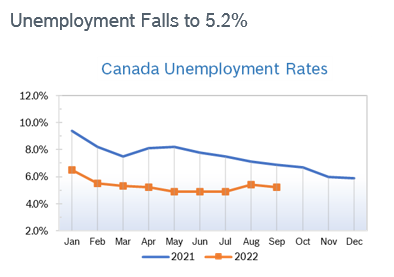Consumer Prices Fall 0.3% The Consumer Price Index (CPI) fell 0.3% in August and was up 7.0% year over year after being up 7.6% year over year in August, according to Statistics Canada. Analysts had expected the monthly CPI to decline even more than it did. Shelter costs dropped for the first time since January 2021, but food costs continued to rise. GDP Rises 0.1% in July GDP edged up 0.1% in July, after increasing 0.1% in June. Growth in goods-producing industries (+0.5%) was partially offset by a 0.1% decline in services-producing industries with 11 of 20 industrial sectors increasing in July. Building materials and supplies sales fell 2.5% in July, primarily due to lower sales of lumber, millwork, hardware and other building supplies. The retail trade sector contracted 1.9% in July, falling to the lowest level since December 2021 as 10 of 12 subsectors decreased. Sales at gasoline stations fell considerably. Advance information indicates that real GDP was essentially unchanged in August. BoC Raises Interest Rates As expected, the Bank of Canada (BoC) raised interest rates by 0.75% in early September, to 3.25%. the Bank of Canada says global inflation remains high because of global supply chain disruptions, the effects of the pandemic and the war in Ukraine. Domestically, the bank says the economy continues to operate in "excess demand." The move was the fifth consecutive interest rate increase this year, pushing the bank's key rate above what it calls the "neutral range" between two and three per cent. The Bank of Canada, along with central banks around the world, has been raising interest rates in an effort to cool sky-high inflation after slashing its key rate to near-zero at the start the pandemic. Housing and Construction News Housing starts fell 2.8% to 267,443 units on a seasonally adjusted annual basis in August, after falling in July. The decline comes amid ongoing concern about a shortage of housing supply in the country. Urban starts fell 3% to 246,771, while multi-unit urban starts were down 4% to 187,602 units. Despite the overall monthly decline, the six-month trend in housing starts remained positive, with the annualized moving average ticking up to 267,309 units in August from 264,467 in July, according to Canada Mortgage and Housing Corporation (CMHC). The level of starts remains historically high and has been well above 200,000 units since 2020. Home sales continued to fall in July, dropping 5.3% from June, to 37,975 homes, down 29% compared with July last year. New listings also fell. The Canadian Real Estate Association (CREA) noted that the monthly decline was the smallest in five months. New listings in July totaled 73,436, down 6% from last July and 5% from June. CREA says that sales are falling due to high prices and climbing interest rates. The Canadian Real Estate Association (CREA) has revised its outlook for home sales this year and next. It now expects a 20% drop in sales this year from 2021 levels, and a further 2.3% decline in 2023. Most of the sales decline is focused in Ontario, Canada's most populous province. CREA said that rising interest rates have cooled interest and priced some people out of the market. The BoC expects home prices to drop 14% overall this year as interest rates rise and demand cools. Bank of Canada has lifted its main benchmark rate by 3% this year, to 3.25%, and a growing number of economists now anticipate rates to peak at 4.0%. CREA expects the national average home price to increase 4.7% in 2022 and remain flat in 2023. Canada’s homeownership rate has declined to 66.5% after peaking in 2011 at 69%, according to a new report from Statistics Canada. They said many people are having a hard time getting qualified for a mortgage and home sales have fallen accordingly. Meanwhile, the growth in renter households has more than doubled compared to the growth of owner households, with renter households growing 21% between 2011 and 2021 compared to the homeownership growth rate of 8.4%. Retail Sales Retail sales fell 2.5% to $61.3 billion in July, the first decline observed in seven months. Sales were down in 9 of 11 subsectors, representing 94.5% of retail trade. The decrease was driven by lower sales at gasoline stations and clothing and clothing accessories stores. Core retail sales, which exclude gasoline stations and motor vehicle and parts dealers, fell 0.9%. In volume terms, retail sales were down 2.0% in July. Retail Ecommerce Sales On a seasonally adjusted basis, retail ecommerce sales were down 0.7% in July. On an unadjusted basis, retail ecommerce sales were up 4.3% year over year to $3.2 billion in July, accounting for 4.7% of total retail trade. The share of ecommerce sales out of total retail sales fell 0.1% compared with July 2021. Retail Notes Canadian Tire held a scavenger hunt in late September to celebrate their 100th birthday. They gave away 100 special edition bills in 19 cities across the country that can be redeemed for $100 in goods from Canadian Tire stores. © Robert Bosch Tool Corporation. All rights reserved, no copying or reproducing is permitted without prior written approval.
Comments are closed.
|
Archives
July 2024
|








